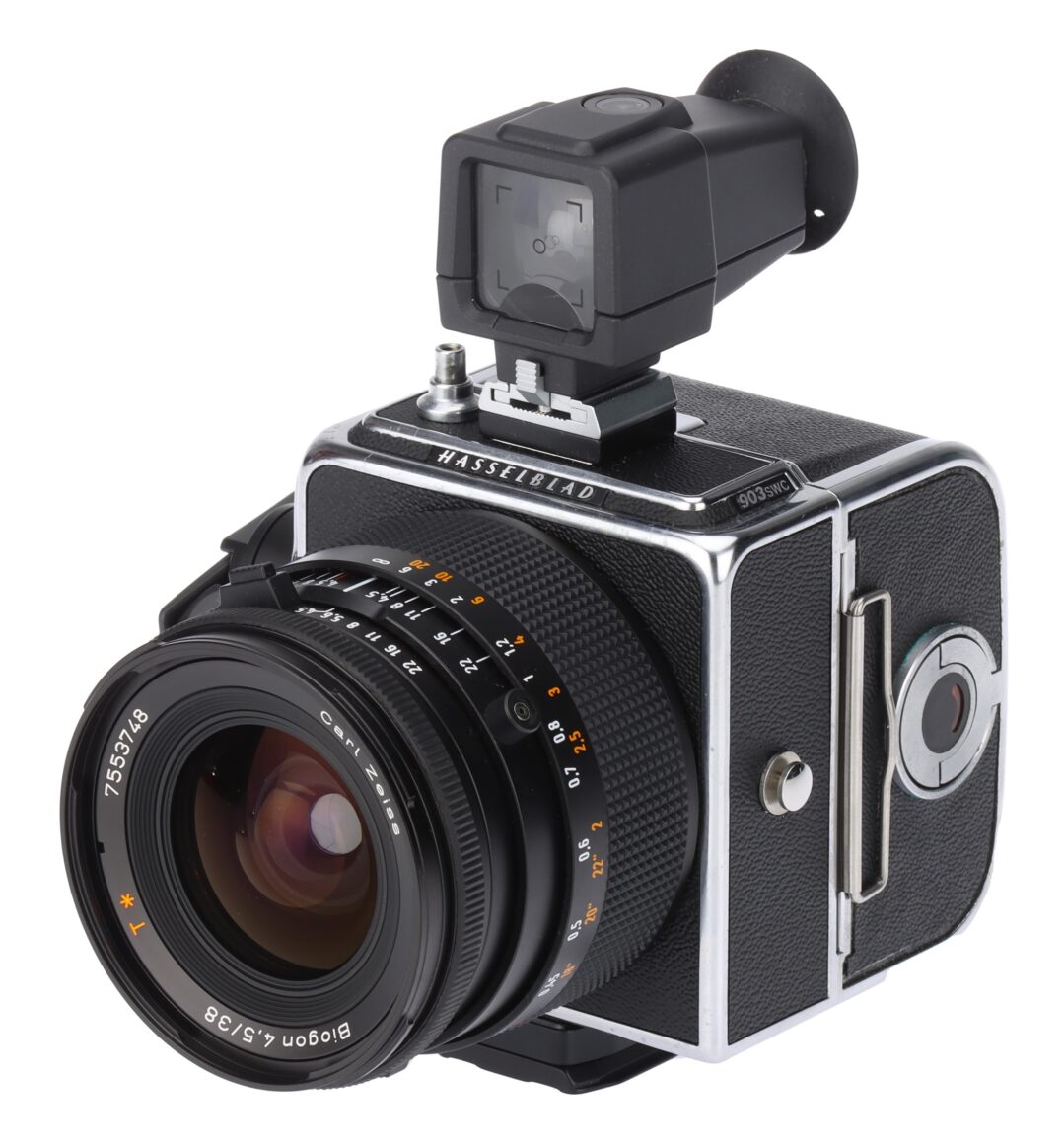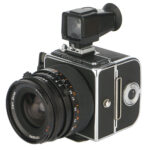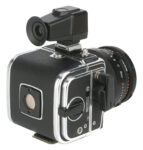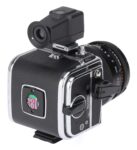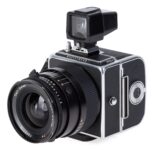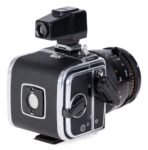Hasselblad 903SWC with Carl Zeiss Biogon T* 38mm F/4.5 CF
Medium format MF film viewfinder camera
Specification
| Production details: | |
| Announced: | 1988 |
| Order No.: | 10052 - chrome |
| 10201 - black | |
| System: | ● Hasselblad V (1957) |
| Format: | |
| Maximum format: | Medium format 6x6 |
| Film type: | 120 roll film |
| 220 roll film | |
| Fixed lens: | |
| Original name: | Carl Zeiss Biogon 4,5/38mm T* |
| Focal length: | 38mm |
| Speed: | F/4.5 |
| Diagonal angle of view: | 92° |
| Lens construction: | 8 elements - 5 groups |
| Diaphragm type: | Automatic |
| Closest focusing distance: | 0.3m |
| Manual focus control: | Focusing ring |
| Leaf shutter type and speeds: | Mechanical Prontor, 1 - 1/500 + B |
| Shutter: | |
| Type: | In-lens leaf shutter |
| Exposure: | |
| Exposure metering: | None |
| Exposure modes: | Manual |
| Physical characteristics: | |
| Weight: | 1325g |
| Dimensions: | 145x112x150mm |
Manufacturer description #1
Industrial and architectural photography place special demands on the photographer's equipment. Often, a very short focal length is required. A picture quality that permits enlargement to exhibition formats. And a camera that can be handled even when you are balancing on scaffolding, hanging out of a helicopter or squeezed into a corner.
The Hasselblad 903SWC probably meets these demands better than any other camera.
It gives a large picture format and extremely high picture quality. Images that are razor-sharp from corner to corner and throughout the focusing range - from 0.3 m to infinity. And virtually no distortion - vertical and horizontal lines are straight, even along the edges of a giant print. The depth of field is staggering, from 0.65 m to infinity at f/22.
The 903SWC is also very compact and handy, and its operation is as simple as it is obvious.
This has made the Hasselblad 903SWC a favorite of leading industrial and architectural photographers. And an excellent and often used general purpose camera for such things as photojournalism, landscape, aerial photography and reproduction work.
A TYPICAL HASSELBLAD.
The Hasselblad 903SWC is a typical Hasselblad when it comes to design, quality, reliability and the interchangeable film magazines. But in spite of all this, it is markedly different to the other models.
The 903SWC is smaller, and even easier to use. It has an optical view-finder with a built-in spirit level and a magnifier so that you can read off the scales on the lens at the same time as you concentrate on the picture. And it has a built-in 90° Biogon lens - acclaimed by many as the best wide-angle lens in the world. It is designed and built by Carl Zeiss according to the same uncompromising principles as the lenses for the very best view cameras.
BUILT WITHOUT COMPROMISES.
The design and construction of the 903SWC are based solely on picture quality, reliability, flexibility and simplicity.
Which is why the true wide-angle lens is mounted permanently on the camera. Which is why the camera body is precision-cast from a single block and built to extremely fine tolerances. Which is why the interchangeable film magazines are small miracles of precision and reliability.
GREAT FLEXIBILITY.
Switching magazine from color film to black-and-white, or from transparency to color negative, is simple and fast. You can take a Polaroid in the middle of a roll to check exposure and composition. And just as easily you can change from 6x6 to 6x4.5, and from 12 to 70 pictures per magazine in seconds.
THE LARGEST SYSTEM.
A photographer investing in a Hasselblad should never be held back due to a lack of equipment. Which is why we have developed the largest medium format system, and designed it so that almost all the components and accessories fit Hasselblad cameras, both new and old.
There are cheaper ways of building a camera and a system, but none that make it a better investment for photographers who earn their living from the pictures they create.
***
The Hasselblad 903SWC is a mechanical wide-angle camera with a permanently attached 38 mm Biogon lens and detachable optical view-finder and optional interchangeable film magazines.
Film format: 2 1/4" x 2 1/4" (6 x 6 cm) and 2 1/4" x 1 5/8" (6 x 4.5 cm) with different magazines.
Film choices: 120 and 220 roll films, 70 mm perforated long rolls, sheet film and Polaroid film.
Lens: Carl Zeiss Biogon CF 38 mm f/4.5 T* true wide-angle lens with 90° diagonal (72° horizontal) angle of view and 60 mm front bayonet mount.
View-finder: Detachable optical view-finder with built-in spirit level and built-in magnifier for reading lens scales through the view-finder. A focusing screen adapter, which is attached to the camera in the same way as the film magazine, is available for checking picture composition and depth of field. The adapter is used together with a focusing or magnifying hood, or a prism view-finder, with or without a meter.
Focusing: Focusing range of lens: 12 ins. (0.3 m) to infinity. Depth of field range: 10 feet (3 m) to infinity at f/4.5 and 26 ins. (0.65 m) to infinity at f/22.
Shutter: Leaf shutter in lens, 1-1/500 s and flash synchronization at all shutter speeds.
Film advance: Simultaneous manual shutter cocking and film advance. Foldable winding crank.
Camera body: One-piece cast aluminium alloy shell with 1/4" socket and plate for tripod quick coupling attachment.
System compatibility: The 903SWC accepts all film magazines made for other Hasselblad models. The Biogon lens mount will accept ⌀60 filters and Softars.
Camera finish: Available with chrome or black finished bodies. Supplied with optical view-finder, carrying strap and front and rear protective covers.
Manufacturer description #2
You'll appreciate what a fantastic wide-angle camera the Hasselblad 903SWC is after the first few shots.
The performance of the Zeiss lens is incredible - a 90° diagonal angle of view for truly unbelievable corner-to-corner clarity of detail and superb contrast over the entire film plane. For close-ups the closest focusing point is 12 in. (0.3 m) and the depth of field is from 26 in. (0.65 m) to infinity at f/22. Distortion is minimal, so that on a 3x3 feet (1x1 m) enlargement straight lines stay straight, even at the edges of the picture.
The 903SWC is unique among Hasselblad cameras. It's the only camera designed specifically to take the super wide-angle Biogon 38 mm f/4.5 lens created by Zeiss of West Germany. The camera body was built around the lens, forming one compact unit with a permanently attached lens. For picture composition you use the detachable viewfinder that fits on top of the camera. It has a spirit level visible through the finder for ensuring the camera is kept level when setting up shots that require perfect alignment.
The 903SWC comes into its own when you want to cover as wide a subject area as possible in a cramped space. At 3 feet (1 m) the lens covers an area approximately 5x5 feet (1.5x1.5 m). To cover a subject 33x33 feet (10x10 m) you don't need to move back further than 20 feet (6 m). The image quality is so high and distortion so low that the 903SWC can even be used with confidence for critical copying applications.
For journalistic photography the 903SWC has the advantage of requiring a minimum of adjustment. The depth of field obviates the need of focusing for every shot. Up to 70% of the 2 1/4 x 2 1/4" (6x6 cm) medium format image can be cropped later and you'll still have a larger negative than if you had used 35 mm.
Like the other Hasselblad system cameras the 903SWC accepts the full range of Hasselblad film magazines, covering a variety of film types, formats and lengths. The Polaroid film magazine can also be used.
If you are using the camera mounted on a tripod and want to work as you would with a large format camera, you only need to attach a focusing screen adapter instead of a film magazine. You can then focus and compose your picture direct on the film plane.
The Hasselblad 903SWC. The perfect choice for wide-angle photography where it's picture quality that counts.
Biogon CF 4,5/38 mm T*
Using a wide-angle lens on a single lens reflex camera normally has its drawbacks, such as poor resolution at the corners of the image and distortion (lines that do not pass throught the centre of the picture are no longer straight).
The problem lies in the lens. In order to make room for the camera's reflex and viewfinder system the lens has to be of the retro-focus type, which means that the distance between the final lens surface and the image plane is large, compared to the focal length of the lens. The lens can be compared to an inverted telephoto lens and the asymmetrical construction compromises the quality obtainable.
The Biogon lens, on the other hand, was developed by Zeiss without having to take the camera's construction into account. The result is a lens with a nearly symmetrical design, according to the classical Gauss principle.
The advantage with a symmetrical design is that certain aberrations can be completely eliminated. Thus with a Biogon lens distortion is reduced virtually to zero and the picture is clear and sharp right out to the corners. Another feature of this remarkable lens is that light fall-off at the corners of the picture is greatly reduced. Leading makers of large format cameras use the same type of lens, and the performance of the 903SWC medium format camera can really only be compared to cameras of this type.
The Hasselblad CF series lens has a built-in shutter with flash synchronization up to the fastest shutter speed - 1/500 s.
From the editor
The lens accepts bayonet-type 60mm filters and a square bayonet-type lens hood Ø60/38-60 40668.
The weight and dimensions are indicated for the camera body with lens and film magazine A12.
Table of contents
Clickable
Technical data
Clickable
Instruction manual
Clickable
Hasselblad V system cameras
Clickable
- Hasselblad 2000FC
- Hasselblad 2000FC/M
- Hasselblad 2000FCW
- Hasselblad 2003FCW
- Hasselblad 201F
- Hasselblad 202FA
- Hasselblad 203FE
- Hasselblad 205FCC
- Hasselblad 205TCC
- Hasselblad 500 Classic
- Hasselblad 500C
- Hasselblad 500C/M
- Hasselblad 500EL
- Hasselblad 500EL/M
- Hasselblad 500ELX
- Hasselblad 501C
- Hasselblad 501CM
- Hasselblad 503CW
- Hasselblad 503CX
- Hasselblad 503CXi
- Hasselblad 553ELX
- Hasselblad 555ELD
- Hasselblad 903SWC with Carl Zeiss Biogon T* 38mm F/4.5 CF
- Hasselblad 905SWC with Carl Zeiss Biogon T* 38mm F/4.5 CFi
- Hasselblad FlexBody
- Hasselblad SWC with Carl Zeiss Biogon [T*] 38mm F/4.5 C
- Hasselblad SWC/M with Carl Zeiss Biogon T* 38mm F/4.5 C
- Hasselblad SWC/M with Carl Zeiss Biogon T* 38mm F/4.5 CF
